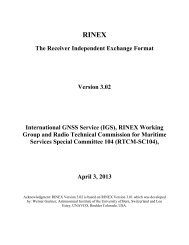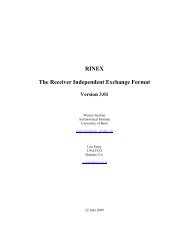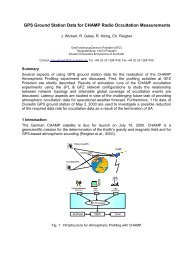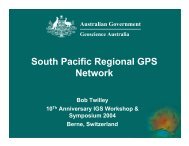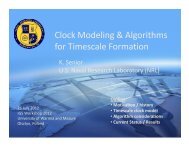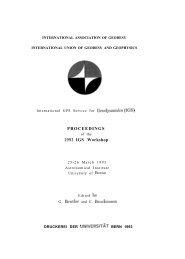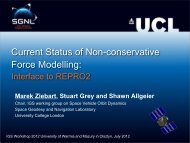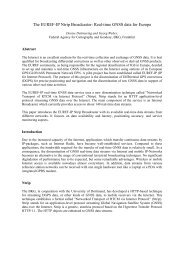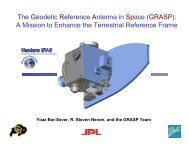International Terrestrial Reference Frame realized by the coordinates and velocities of the<strong>IGS</strong> tracking stations [Blewi?f et al., 1993; Bock el al., 1993]. Fortunately, the <strong>IGS</strong> beganits test campaign several weeks before the Landers earthquake sequence so that the globaltracking network was quite robust. The PGGA results were the first demonstration of subcentimeter-levelcomputation of coseismic displacements with respect to the ITRF anddemonstrated the synergism between regional clusters and the <strong>IGS</strong>.In August 1991, S10 began analyzing data from the PGGA on a daily basis. In order tocompute precise satellite ephemerides, data from the available global tracking stations (pre-<strong>IGS</strong>) were analyzed simultaneously with the PGGA data, Initial solutions of PGGA andglobal data included a manageable number (15-20) of regional and global stations and 15satellites so that the simultaneous analysis of all station data was straightforward. By thetime of the Landers earthquake the total number of stations had increased to 25 with 18satellites, still a manageable number for a simultaneous analysis. Today the <strong>IGS</strong> GlobalData <strong>Center</strong>s archive data from over 50 stations and 25 active GPS satellites. S10 currentlyanalyzes 32-35 stations in a simultaneous adjustment of 24-hour sessions, including bothPGGA and global <strong>IGS</strong> data. With current processing schemes, top-of-the line scientificworkstations and abundant disk space, the daily, simultaneous analysis of 35 stations isstill manageable. However, as the number of stations increases above this number, thecomputation time and disk-space requirements are approaching a critical stage.Considering that we expect the number of PGGA stations to increase by at least fivestations over the next few months and that several useful global stations will come on line,we have begun tests on distributed processing of PGGA and <strong>IGS</strong> data. Initial results fromthese tests are described below.4.3 Distributed <strong>Analysis</strong>: One Approach.Au@ is tools. The PGGA and <strong>IGS</strong> data are currently adjusted simultaneously at S10 inindependent twenty-four hour (0-24h UTC) segments using the GAMIT GPS software[King and Bock, 1993]. A weighted-least squares algorithm is used to produce a series oftightly-constrained and loosely-constrained solutions including the estimation of stationcoordinates, satellite initial conditions, tropospheric zenith-delays and phase ambiguityparameters [e.g., Feigl et al, 1993]. The adjustments and corresponding variancecovariancematrices for the station-coordinate parameters are output from the tightlyconstrainedadjustments in a format suitable for a standard weighted least squares networkadjustment of station coordinates from both ambiguity-free or ambiguity-resolved (biasesfixed)solutions [e.g., Bock et al., 1985; Dong, 1993]. In the loosely-constrainedadjustments (also output for ambiguity-free and ambiguity-fixed solutions), the portion ofthe variance-covariance matrix for station d orbital parameters is recorded in an auxiliaryfile, henceforth referred to as a “solution file.” In this representation, the underlyingterrestrial reference frame is essentially undefined (a free network adjustment), although thephysical models are implicit in the partial derivatives that were used to form the variancecovariancematrices (as is the case, of course, for the tightly constrained adjustments).The solution files can then be manipulated to estimate any combination of station positionsand velocities, orbital elements and earth orientation. This is done with the GLOBKsoftware [Herring, 1993] which uses a Kalman filter formulation [Herring et aL, 1990] tocombine the auxiliary files, with the ability to treat each type of parameter stochastically.This appro~ch allows us the combination and, if necessary, the quick re-analysis of manydaily IGWPGGA solutions (we’ve generated at S10 almost 1000 of these daily solutions)using different terrestrial reference frames and with different station/orbitaUearth orientationconstraints. (Of course, if we would like to modify the underlying physical models thenthe individual, daily GAMIT solutions would need to be repeated, a formidable but not81
impossible task for 1000 days of data). Furthermore, this approach allows for thecombination of data from many regional clusters, in combination with the global trackingstations (i.e., distributed processing).The system developed at S10 for GAMIT/GLOBK users can be viewed as a prototype forone possible way in which <strong>IGS</strong> can support campaign-type surveys and regional clusters.S10 archives each day the following information:(i) “clean” RINEX files for the PGGA and global tracking stations. Although GPSsoftware packages provide “automatic” cycle-slip fixing algorithms, there are frequentanomalous conditions when human interaction is required. Providing access to cleanRINEX data for a robust global (and California regional) network provides a considerabletime savings for principal investigators, regardless of the software package, but particularlyfor packages that examine doubly -differenced phase measurements (e.g., Bernese,GAMIT).(ii) Coordinates and velocities for the <strong>IGS</strong> and PGGA stations in the current standardglobal reference frame.(iii) The GAMIT/GLOBK solution files. These files are an invaluable resource for theanalysis of regional networks since they contain the complete geodetic content of the globaltracking network, as described in this proposal. Once a standard software-independentexchange format is adopted for solution files this information will be readily available to allusers and GPS data processing packages.(iv) precise ephemerides in a short ASCII file that includes a set of 9 initial conditions (sixstate vector elements of position and velocity, and three radiation pressure parameters) foreach satellite at the midpoint of each day (12:00 UTC), Since all GAMIT users use thesame orbital integration program, it is a simple manner to generate a tabular ephemeris for aparticular survey. This of course reduces the amount of orbital data that needs to betransmitted via electronic mail, compared to the transfer of many times larger NGS SP3formatted files which are made available to the general user. An Earth orientation file basedin the S10 analysis is also circulated,4.4 Distributed <strong>Analysis</strong> — Four ScenariosScenario 1. This is a zeroth order example of distributed processing and the <strong>IGS</strong> concept,A surveyor goes to the field in southern California with one receiver knowing that thePGGA/<strong>IGS</strong> network is operating continuously, The current distribution of stations insuresthat any user in southern California will be within 100 km of a PGGA station. Thesurveyor occupies a set of stations in some GPS surveying mode (e.g., static, rapid-static)for a specified time depending on the application and accuracy requirements. At the end ofthe survey, the following information is copied electronically from the PGGA: RINEX datafor the one or two closest PGGA sites, satellite ephemerides in NGS SP1 or SP3 format,time-tagged station coordinates (ITRF) for the reference PGGA site. Using thisinformation and any of the scientific or commercial GPS software packages, the usercomputes station positions using the satellite orbits and PGGA station coordinates as fixed.This is a si~ple straightforward procedure in which PGGA/<strong>IGS</strong> plays strictly a servicerole. Depending on the length of time of a particular survey and assuming that standardfield procedures have been followed, the station coordinate information can be used bygeophysicists to study crustal deformation. This information could be retrieved in the formof solution files, in this case, strictly the solutions and variance-covariance matrices forstation coordinates which could easily be integrated with the PGGA/<strong>IGS</strong> solution files.82
- Page 1 and 2:
●INTERNATIONAL ASSOCIATION OF GEO
- Page 3 and 4:
TABLE OF CONTENTS.FINAL AGENDA . .
- Page 5 and 6:
13:30 NGS14:00 S1014:30 EMR15:00 CO
- Page 7 and 8:
LIST OF PARTICIPANTS:Prof. Gerhard
- Page 10 and 11:
Table 1. Current IGS Analysis Cente
- Page 12 and 13:
The first field identifies the reco
- Page 14 and 15:
Summary InformationThe third produc
- Page 16 and 17:
From Figure 1 we find that there ar
- Page 18:
to define a reference clock in thei
- Page 22 and 23:
SESSION 2(IGS orbit products)
- Page 24 and 25:
1. introductionThe main objectives
- Page 26 and 27:
ecause of the above averaging. This
- Page 28 and 29:
RMS per center (m)o 0 0 0 0 0 oA0Iv
- Page 30:
Scale (ppb)I I I I I 11+-b~ul0Amo&I
- Page 33 and 34: and NGS. Note that the day to day v
- Page 35 and 36: Rotation around X-axis (mas)1&0 0o
- Page 37 and 38: discussed in Section 3 are here see
- Page 39 and 40: -----------------------------------
- Page 41 and 42: Residuals in Meters1 1 1 1 1 1 1=%m
- Page 43 and 44: Residuals inMeters11111cnficJJw-o A
- Page 45 and 46: I I I—Residuals in Meters..—.
- Page 47 and 48: 1111ResidualsMeters,—{44
- Page 49 and 50: Residuals in MetersI I I II I I IIc
- Page 51 and 52: Rms in MetersI 1 ! I 1 10 n0 a0n.ff
- Page 53 and 54: IGS- and the COM-sets, but that the
- Page 55 and 56: Table 4.1 N.A. Baseline Repeatabili
- Page 57 and 58: ..Figure 5.1:Clock solutions for FA
- Page 59 and 60: specifically the preanalysis can be
- Page 61 and 62: discussion, a question as to whethe
- Page 63 and 64: SUMMARY OF SESSION 3This Session be
- Page 65 and 66: IGS POSITION PAPER, IGS ANALYSIS CE
- Page 67 and 68: and Earth orientation parameters (E
- Page 69 and 70: LbPIERS and IGSCentral Bureausand D
- Page 71 and 72: @ IGS will develop instructions, an
- Page 73: 2.2 Analysis Center System DesignFi
- Page 76 and 77: applied to the solution in order to
- Page 78 and 79: ..standard deviations. This is conv
- Page 80 and 81: known, the two solutions will be ad
- Page 82 and 83: errors, and can therefore be used a
- Page 86 and 87: Thus, there is the potential of fee
- Page 88 and 89: 90” 100” 110” 120” 130” 1
- Page 91 and 92: adiation parameters for each satell
- Page 93 and 94: Bock, Y., R.I. Abbot, C.C. Counselm
- Page 95 and 96: SUMMARY OF SESSION 4This session st
- Page 97 and 98: INTERNATIONAL EARTH ROTATION SERVIC
- Page 99 and 100: x- differences with IERS0.001”I I
- Page 101 and 102: SUMMARY OF SESSION 5In the last ses
- Page 103 and 104: 1) I(X3 PROCESSING/REPORTS/FORMATSS
- Page 105 and 106: IGS should foster and encourage reg
- Page 107 and 108: ..INTERNATIONAL GPS SERVICE FORGEOD
- Page 109 and 110: ortL.s.4
- Page 111 and 112: 1234567a91011121314IsIt17ItIs2C2122
- Page 113 and 114: . Ruth Neilan16S Central BureauJet
- Page 115 and 116: ON1T.>● Jim ZumbergeJet Propulsio
- Page 117: PROPOSED ORGANIZATION OF THE INTERN




